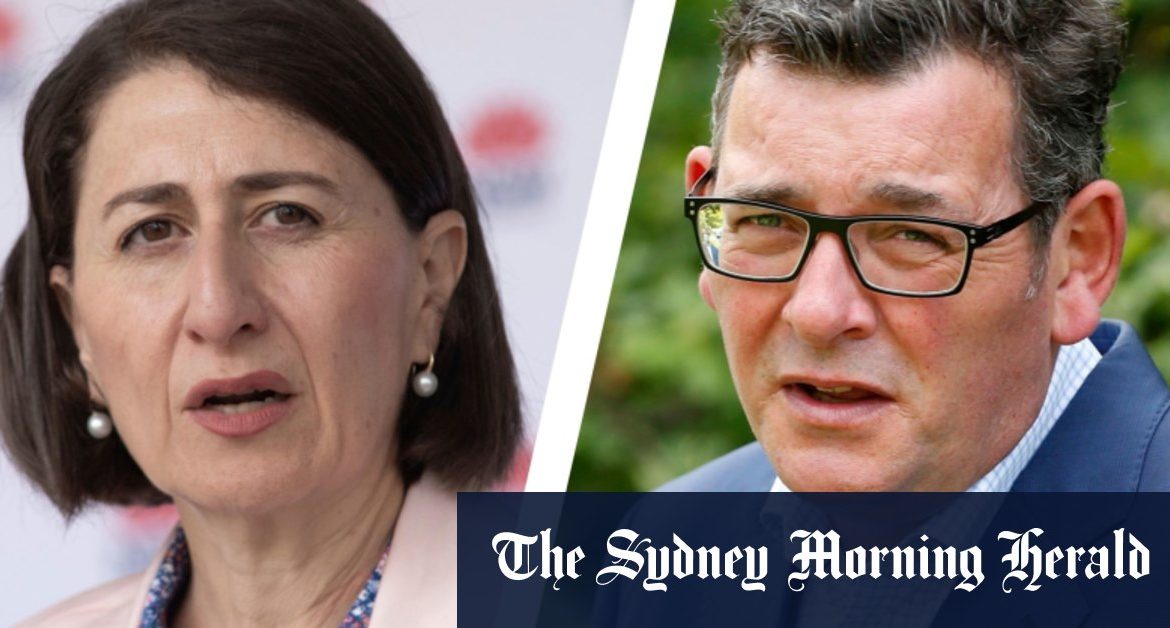However, Woollahra and Waverley, which are considered ‘orange zone’ councils, have recorded eight cases between them, with two unknown sources. Under orange-zone rules, you can apply for a permit to travel, provided you get a COVID-19 test within 72 hours of arriving in Victoria and isolate until you get a negative result.
Ms Berejiklian said the decision by Victorian Premier Daniel Andrews to downgrade 25 Sydney local government areas to ‘orange’ on Monday should have been taken “a long time ago”.
“First of all I don’t really understand the traffic light system, I just want to make that clear,” Ms Berejiklian said on Tuesday from the NSW North Coast.
NSW Premier Gladys Berejiklian and Member for Tweed Geoff Provest meet with sugercane farmer Robert Quirk on Tuesday.Credit:Louise Kennerley
“I just say to my colleagues please base your decision on the science and the facts.”
Mr Andrews said a decision to move Sydney to a ‘green’ classification was likely “a few weeks away” due to the city’s coronavirus outbreak.
“It’s not a reflection on their communities. It’s not a reflection on them,” Mr Andrews said of the 10 red zone councils.
“It’s a reflection on the fact that this is a wildly infectious virus and this is a government, the government that I lead, that follows public health advice.”
Health authorities are yet to find the source of nine infections recorded in western and northern Sydney over the past four weeks, as the state on Tuesday recorded a second consecutive day without a local case.
As Victoria and the ACT reopened to more Sydney local government areas this week, Queensland has said it will be looking for 28 days without a “mystery case” in the city when it considers reopening its border on January 28.
While all cases in Greater Sydney have been genomically linked to either the Avalon cluster or the Berala cluster, some “mystery cases” remain without an epidemiological link: a known point of transmission from a case within an existing cluster.
The most recent mystery case is an infection in an Auburn man, reported on Saturday. He subsequently infected six close contacts who were reported the following day.
Others include the western Sydney man who presented to Mount Druitt Hospital emergency department and a case in the Elanora Heights/Narrabeen postcode, within the upper northern beaches zone, which were both reported on January 10. Each of the cases’ partners also became infected.
Cases from the Bilgola, Wentworthville/Greystanes, Belmore and Palm Beach areas are also marked as under investigation.
In addition, two cases – one in the Lane Cove area identified on December 23 and one in the Punchbowl area identified on December 16 – have been declared by NSW Health as having no known links to existing cases.
A NSW Health spokesperson said there is no set time period as to when a case is declared as having an unknown source, adding there is often an “ongoing investigation” for these cases.
“Links can sometimes only become apparent well into the investigation as additional information comes to light,” the spokesperson said.
Concerns are still being expressed over low testing numbers in NSW.
There were 10,621 tests recorded during the 24-hour reporting period, up from 8773 on Monday. The state is aiming for daily testing figures of 25,000 to 30,000.
“The testing rates are a bit higher today than they were yesterday but still not high enough for our liking,” Ms Berejiklian said, repeating her statements that higher figures would be needed for the government to consider easing restrictions in Greater Sydney.
Monday and Tuesday’s testing numbers are usually lower as they reflect weekend turnout.
She indicated the government would likely consider moving to ease several restrictions at once so businesses didn’t need to “chop and change all the time”.
The Premier refused to buy into predictions that Australia wouldn’t see international tourism in 2021, saying she remained open-minded.
Ms Berejiklian added that any further government assistance would likely be tailored to struggling industries.
“Some sectors are weathering the storm of the pandemic better than others and I think any future response can be more targeted,” she said.
The state government has urged local businesses to register for its Dine & Discover voucher program, announced in last year’s budget.
All persons over 18 will be eligible for four $25 vouchers: two to spend on food and drink at registered hospitality venues from Monday to Thursday and two for entertainment and recreation, including museums, live music and arts venues on any day of the week.
There will be a pilot at The Rocks and in Broken Hill in early February, followed by an expansion to the northern beaches, Sydney CBD and Bega. The vouchers are expected to be available for use statewide by March before expiring on June 30.
Get our Coronavirus Update newsletter
Stay across the news you need to know related to the pandemic. Sent Monday and Thursday. Sign up here.
Tom Rabe is Transport Reporter with The Sydney Morning Herald.
Mary Ward is a health reporter at The Sydney Morning Herald.
Most Viewed in National
Loading







